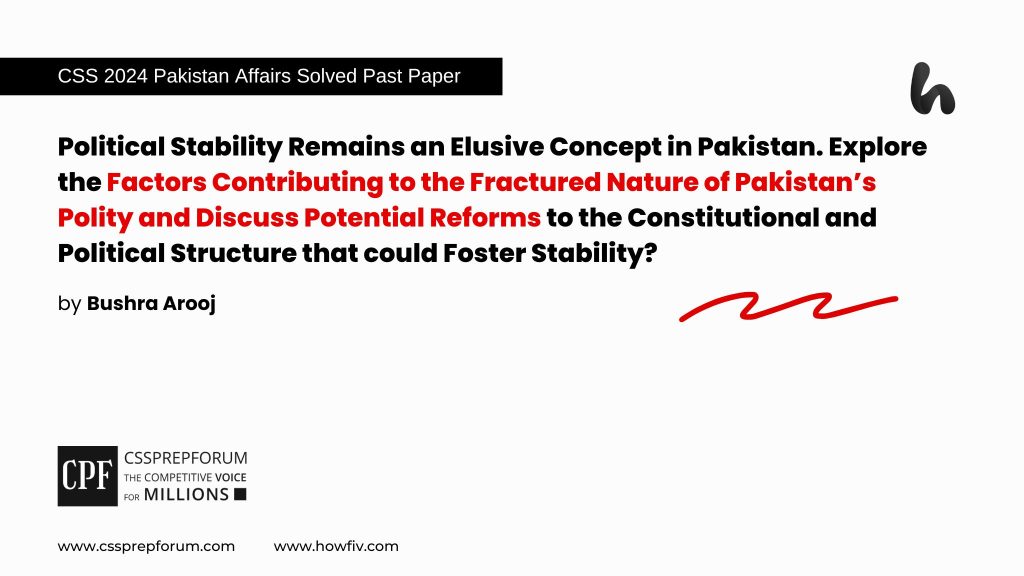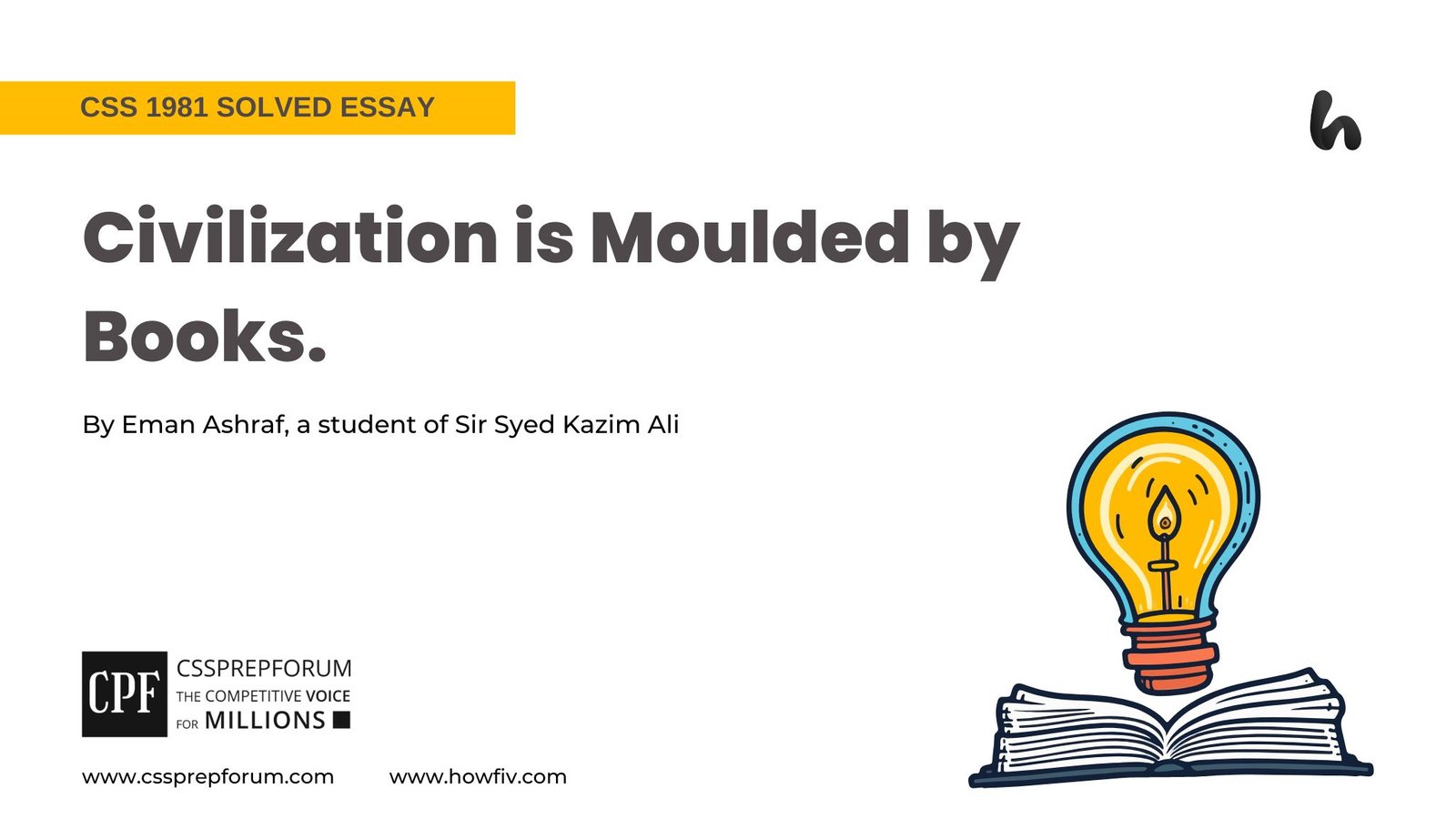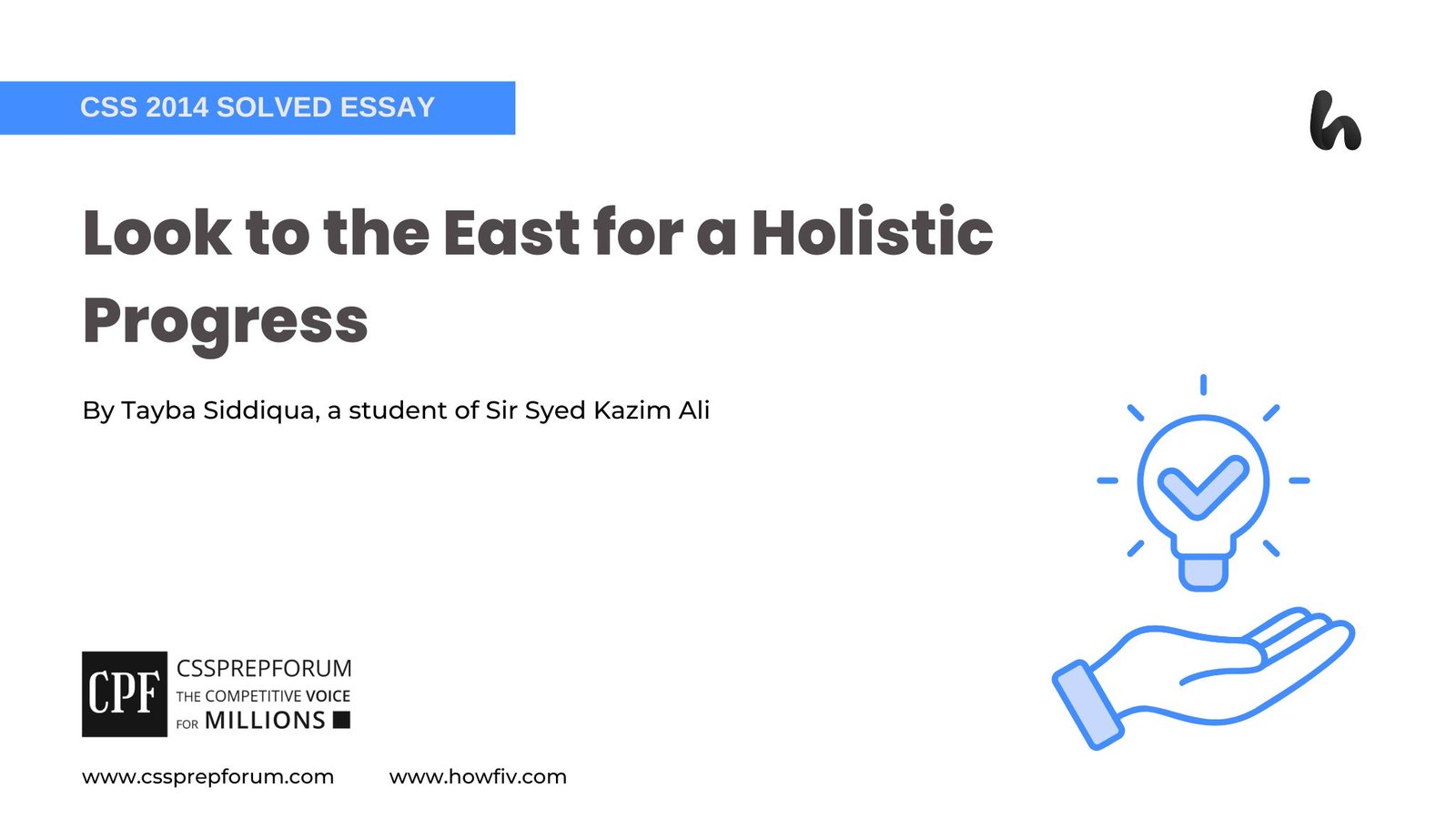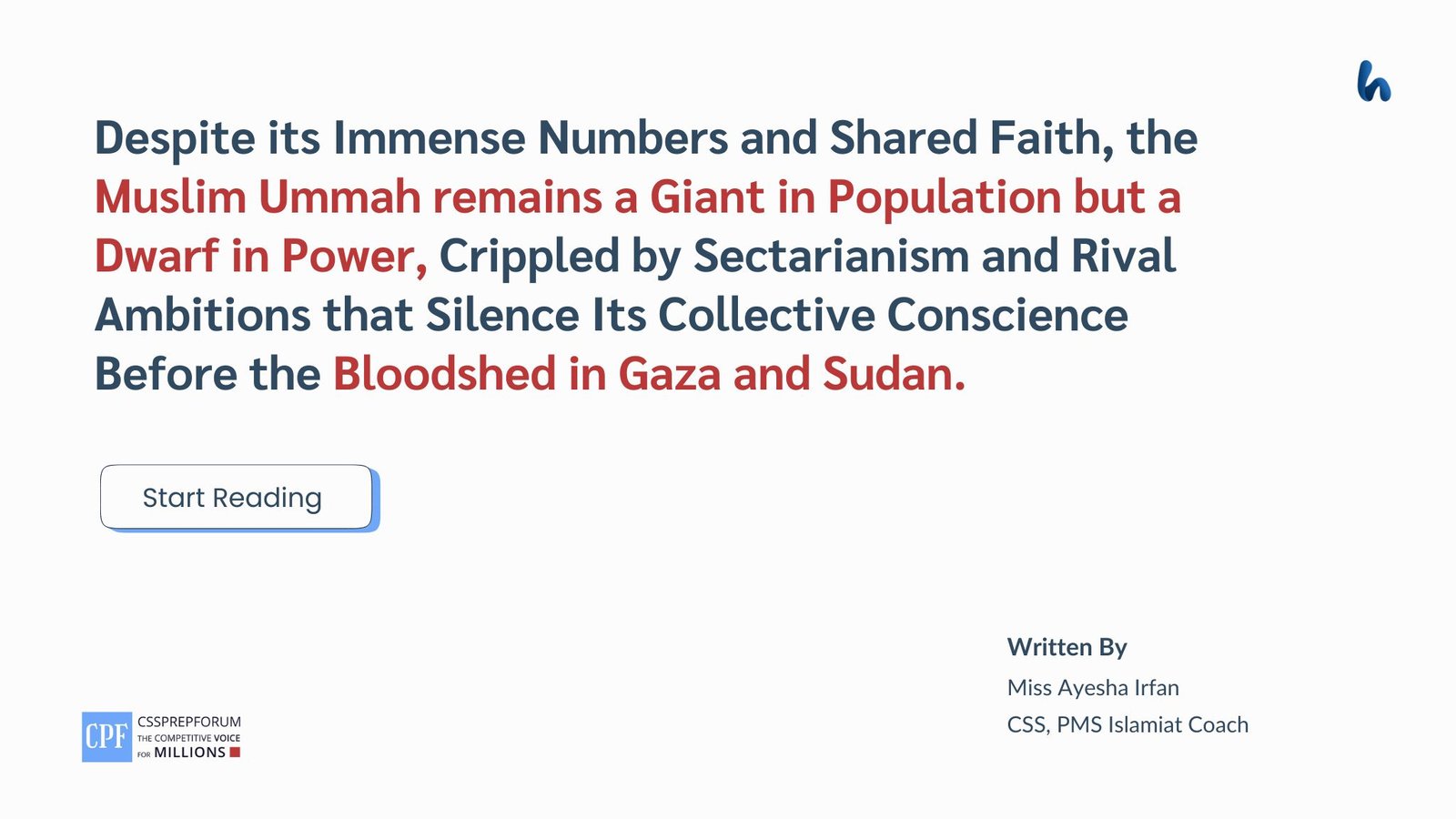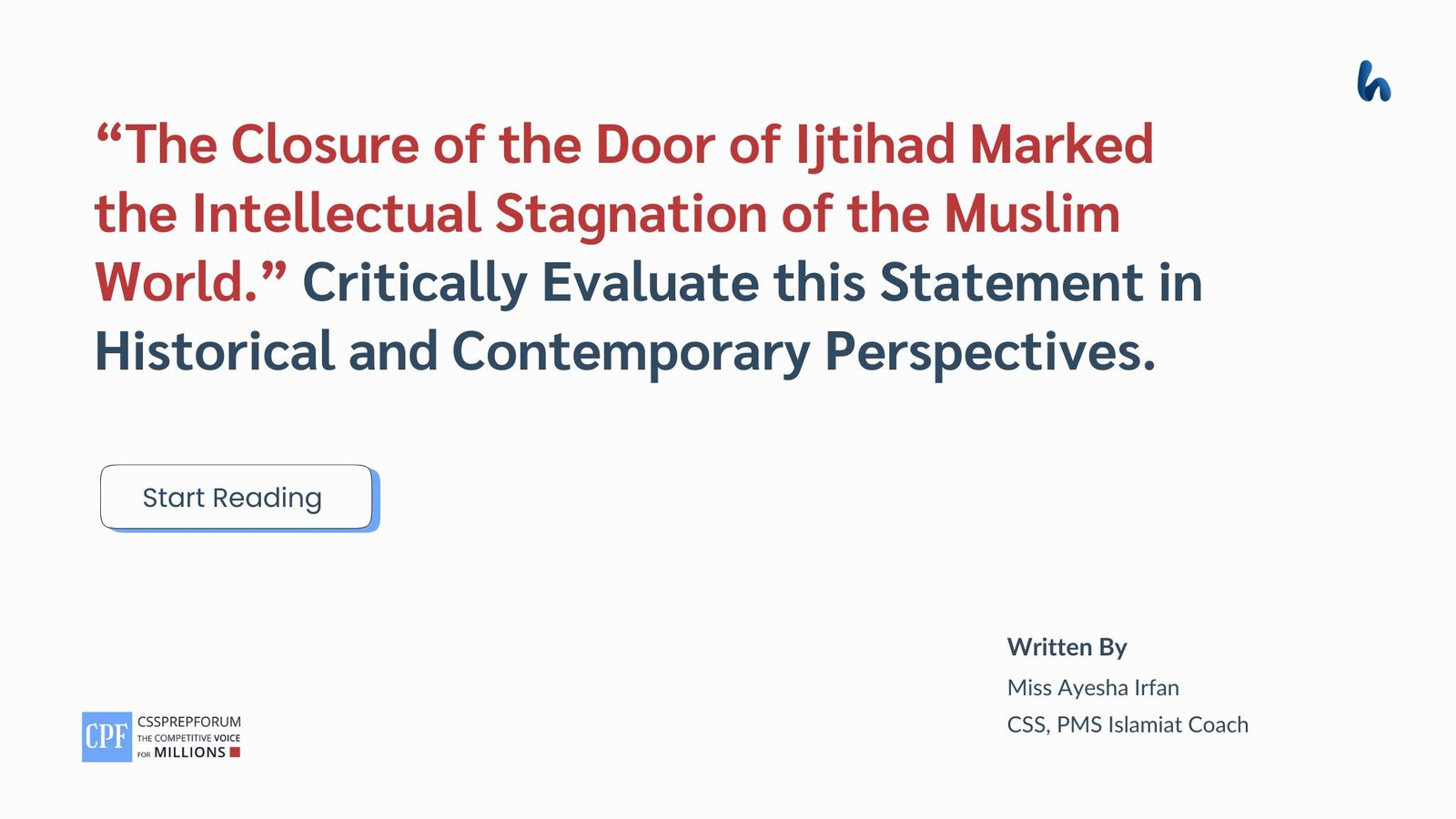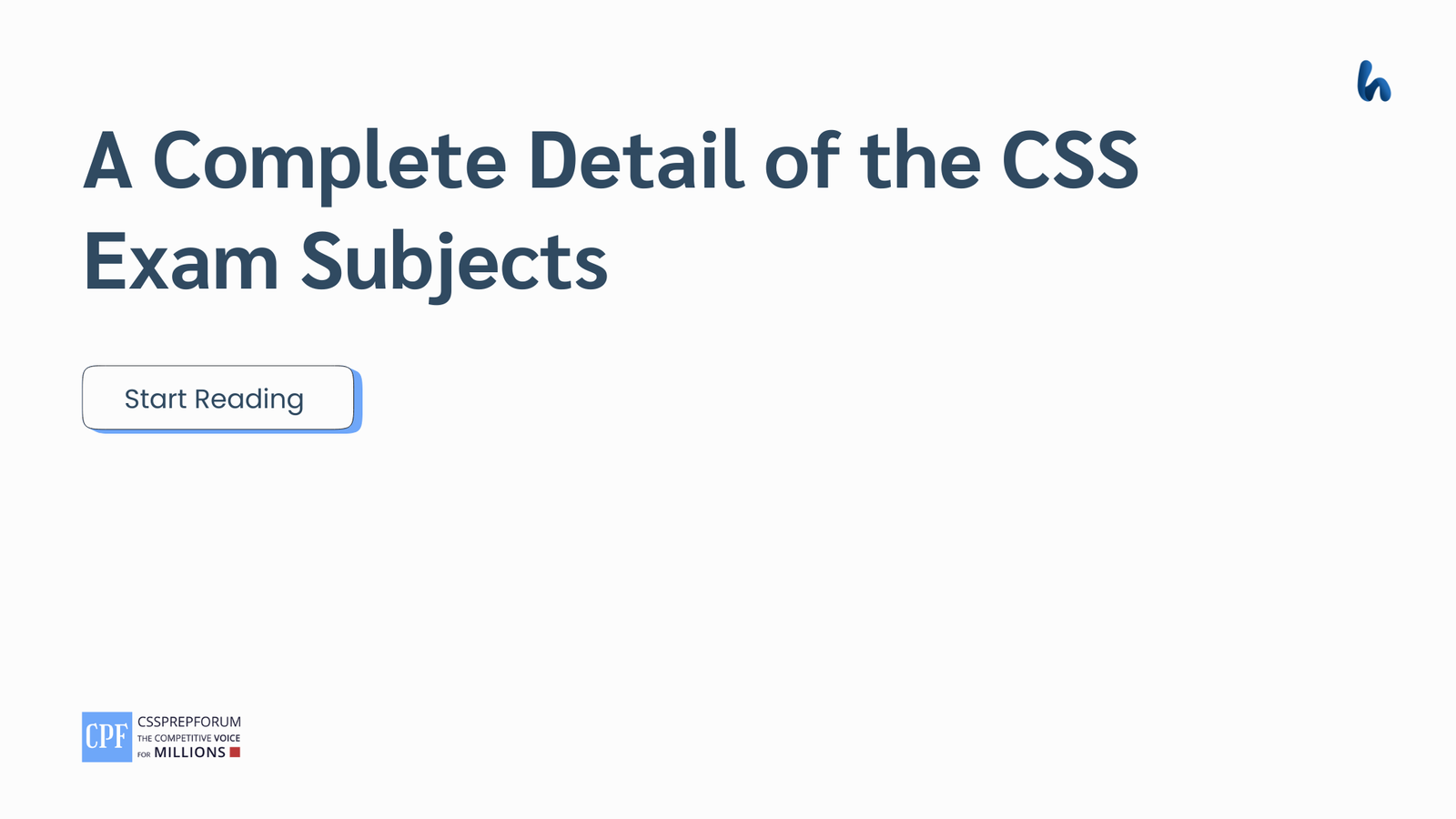CSS 2024 Solved Pakistan Affairs Past Papers | Factors of Political Instability in Pakistan
The following question of CSS Pakistan Affairs 2024 is solved by Miss Bushra Arooj, Pakistan’s Best Pakistan Affairs Coach, on the guided pattern of Sir Syed Kazim Ali, which he taught to his students, scoring the highest marks in compulsory subjects for years. This solved past paper question is uploaded to help aspirants understand how to crack a topic or question, how to write relevantly, what coherence is, and how to include and connect ideas, opinions, and suggestions to score the maximum.

Question Breakdown:
In this question, the examiner has asked you two things: first, about the factors contributing to the fractured nature of Pakistan’s polity, and second, regarding the potential reforms to the constitutional and political structure that could foster stability. So, first, you need to briefly introduce the things that are going to be a part of your answer with a historical background about the politics of Pakistan. Then, write your answers by splitting them into parts as the question demands. Finally, end your answer with a critical analysis and conclusion. The following solved question provides a comprehensive answer covering all the main aspects. However, as far as the answer in the paper is concerned, limit yourself to 3 or 4 leading arguments against each part of the question.
Outline
1- Introduction
2- Historical background of the Factors Contributing to the Fractured Nature of Pakistan’s Polity
3- What Are the Factors Contributing to the Fractured Nature of Pakistan’s Politics?
- ✓The Competition between the Provinces for Ethnic Hegemony
- ✓Governance Crisis
- ✓Lack of Responsible Opposition
- ✓Constitutional loopholes and the Issue of Loyalty Shift by the Members of the Political Parties
- ✓Lack of Political Legitimacy of Elected Governments
- ✓Institutional Interventions and Overthrowing of Democratically Elected Governments
- ✓Lack of Democratic Political Institutionalization
- ✓The Politics of Patronage
4- What are the Potential Reforms to the Constitutional and Political Structure that could Foster Stability?
4.1- Political Reforms
- ✓By Moving toward the Institutionalization of Political Parties
- ✓By Promoting Intra-Party Democracy and Fair Intra-Party Elections
- ✓By Involving Capable Politicians in the Political setup reinforcing Bottom-Top Merit-Based Rise
- ✓By Promoting National Integrity and Unity
4.2- Constitutional Reforms
- ✓By reforming the Constitutionally provided Mandate of the Election Commission of Pakistan (ECP) to introspect the Intra-Party elections
- ✓By Applying Constitutional Limits to Disintegrate the Top-Down Political Nexus
- ✓By Revisiting Article 63 A to Shut the Door of Defection and Floor Crossing
- ✓By Promoting National Integrity and Unity by Constitutionally ProvidedBarriers
5- Critical Analysis
6- Conclusion

Answer to the Question
Introduction
In the 21st century, the political stability of a country is a reiteration of its politico-economic and social development and ensures its international standing. On the other hand, political instability poses a serious threat to its sovereignty. Unfortunately, Pakistan also stands among those countries that have remained indulged in grappling with the political instability that marred its socio-economic growth and development. As it is aptly said by Ishrat Hussain, a Pakistani Economist, in his book ‘Governing the Ungovernable,’ economic progress devoid of political legitimacy may prove elusive and transient, leaving no lasting footprints. Moreover, the economy and economic players require a stale political environment. However, the reason behind the chaotic political environment and its absurd crisis is the competition between the provinces for ethnic hegemony that inhibits the cooperation between their respective political parties. In addition, the lack of responsible opposition obstructs the democratic institutionalization of the state polity, leaving a power vacuum filled by authoritarian governments that stimulate the vicious cycles of instability. Adding fuel to the fire, the non-elected institutional intervention in governmental decision-making further reduces the political legitimacy of the incoming incumbents. Nonetheless, constitutional and political reforms can help to break the vicious cycles of political instability. Politically, at the party level, there is a dire need for democratic institutionalization and reforms in intra-party elections. Furthermore, the other issues can be abated by involving literate politicians in the political setup, promoting national integrity and unity. Constitutionally, providing constitutional safeguards to a neutral forum that introspects intra-party corruption and applying constitutional limits can help to disintegrate the top-down political nexus.
Historical Background of the Factors Contributing to the Fractured Nature of Pakistan’s Polity
Historically, Pakistan’s political system has remained highly unstable, chaotic, and polarized, where stability may prove transient. Following is a bird eye view of the historical political landscape of the country.
In the first phase of the political history of Pakistan (1947-58), the death of Jinnah led to a leadership crisis, and the Pakistan Muslim League could not morph into a nationalist party. The political instability was high, and seven civilian governments have remained unable to maintain a coalition.
In the Second Phase (1958-1969) of the political history, the military intervened in politics, and martial law was declared by President Iskandar Mirza in 1958. At first, chief martial law administrator Ayub Khan devised a plan for his political counterparts where they had been suppressed and restricted from indulging in politics. At last, he reluctantly legalized the ‘Political Parties Act’ and provided access to his political rivals to reinforce his reign.
In the Third Phase (1969-1979), martial law was again promulgated by General Yahya Khan in 1971, whereas the politically unstable environment led to the fall of Dhaka. The chaos was caused by the ongoing tensions between Zulfiqar Ali Bhutto and Mujib-ur-Rehman, leaders of the Pakistan People Party (PPP) and Awami League (AL) from East and West Pakistan, respectively. In 1970s, a controversy about the dominance of Sindh and suppression of Muhajars destabilized politics, and a power vacuum created by their clash provided the way for the military to politics.
During the Fourth Phase (1979-90), another decade of military rule shocked the entire political structure to the depth of its roots. However, after obtaining their right, the political parties strengthened their holds by promoting patronage. In 1990s, the civilian governments got back into politics by uplifting martial law, but now the political parties evolved in a dynastic style. One after another, two dynastic political parties gained control and remained involved in steering political governance.
In the Fifth Phase (1990-2013), an attempt was made again to change the country radically by military personnel General Musharraf. However, he also followed the path of his military counterparts, taking refuge by patronage to legitimize the rule. The dynastic parties got their power back, and the opposition party was not strong enough to compete against the dynastic counterparts. Interestingly, despite strong co-option between the two dynastic parties, namely Pakistan-Muslim-League-N (PML-N) and Pakistan-People-Party (PPP), their formed governments have remained unable to complete their rule. The political instability surfaced in the political dynamics and was marked by overthrowing the government to gain control and regaining control to overthrow others. None of them has proved able to legitimize their regime.

What are the Factors Contributing to the Fractured Nature of Pakistan’s Politics?
- ✓The Competition between the Provinces for Ethnic Hegemony
The lack of cooperation between the political parties has marred the functioning of the political system. The disintegrated political parties representing their local interests have never agreed to sacrifice their interests. However, the dynastic political parties would never allow other political parties to strengthen their designs because the former considered the latter a threat to their hegemony. At the national level, the dominance of Punjab over the smaller provinces created a controversy, where the party of one province tried to reduce the supremacy of others for their ethnic interests. For illustration, the PML-N and PPP only co-opt when there is a threat to their hegemony. The lack of coalescence between the political parties signifies their ideological differences and strive for ethnic supremacy.
- ✓Governance Crisis
The country has a multi-ethnic and linguistic population, and destabilized politics created hurdles in governance by decreasing the legitimacy of the elected governments. However, the fissures and fragmentation in the social fabric contributed to the crisis of governability. According to the analysts Adeel Malik and Maya Tudor, the lack of political legitimacy and achievement of economic stability led to the crisis of governability. However, the constituency politics and coalitions reinforced the societal norms that resulted in favoritism, nepotism, and corruption. According to Ishrat Hussain in his book ‘Governing the Goverable’, kinship nepotism is one of the reasons for the erosion of state authority and subversion of law and rules. As a result, it caused irreparable damage to the political stability.
- ✓Lack of Responsible Opposition
Furthermore, the lack of responsible opposition motivated by individual interests induced great shocks to the political governance. According to a factor analytics, Anwar Syed, the feudalistic ethos that pervades politicians resulted in intolerance of rivals, the expectation of subservience to lower orders, a propensity for violence, and disregard for the law. These credentials shocked the whole political setup. In addition, the military prolonged rules and governance models that discouraged civil political involvements destabilized the political setup for incoming governments.
- ✓Constitutional loopholes and the Issue of Loyalty Shift by the Members of the Political Parties
In addition, at the party level, political parties had created a path dependency in their formative phase. The feudalistic ethos in the politicians resulted in their choice of shifting loyalties, which obstructs the democratic institutionalization of parties. To tackle the menace of floor crossing and defection, Article 63 A of the Constitution of 1973 provided for the disqualification of the defecting member of any party. Thus, it ensures the loyalty of the members toward their party. But only de-seating or defecting members for horse-trading is not enough to abate this menace.
- ✓Lack of Political Legitimacy of Elected Governments
Political history has witnessed the crisis of political legitimacy of elected governments; however, there are myriad reasons behind it, based on the difference of priorities of the polity of different federating units that destabilized politics. In seventy-seven years, the country has governed under twenty-three prime ministers, but no one completed his tenure of premiership. At the party level, there is a leadership crisis to the extent that no party can morph into a national party. For illustration, PPP dominates in Singh, JUI in KPK, while PML-N and PTI dominate in Punjab. At the National level, the conflict competition and struggle for supremacy between provinces destabilizes the politics.
- ✓Institutional Interventions and Overthrowing of Democratically Elected Governments
Moving forward, the military interventions and overthrowing of democratically elected governments destabilized politics at an unprecedented level. The country’s political governance has remained under four martial laws from (1958-89) by Ayub Khan, Yahya Khan (1969-1971), Zia ul Haq (1979-89), and Parvez Musharraf (1999-2006); however, all of them blatantly suppress the political rivals and obstructed civil political intervention. According to Ishart Hussain in his book ‘Governing the Ungovernable’, the military over civilian leadership is overpowered due to its strength as an organized institution. Conversely, the weakness of politics is due to its disorganization as an institution. Political legitimacy is indispensable for a stable polity; unfortunately, the country lags in achieving it significantly.
- ✓Lack of Democratic Political Institutionalization
As discussed previously, the dismal state of the polity as an institution has weakened its capability and capacity. Historically, the fractured nature of the polity as an institution is due to the delay in constitution-making and dispute-solving within different political units. Furthermore, the politics of patronage, the dynastic nature of political parties, and polarized polity contributed to the failure of political parties to prove effective and capable at the national level.
- ✓The Politics of Patronage
Additionally, the politics of patronage exacerbated the polarization in a way that political parties aptly secure their interests by seeking patronage. The constituency politics and its reinforcement created a top-down nexus reinforced by kinship ties. However, military and civil governments have sustained their rule by providing patronage. For illustration, according to Anatol Lieven in his book ‘Pakistan a Hard Country’, military dictators tried to change the state radically, suspended the credentials of patronage, but restored them to legitimize their rule.
What are the potential reforms to the constitutional and political structure that could foster stability?
A- Political Reforms
- ✓By Moving toward the Institutionalization of Political Parties
The political parties must be institutionalized to foster political stability. As discussed earlier, political parties failed to organize as capable and effective institutions. However, to abate the problem, merit-based allocations, strengthening intra-party democracy, fostering accountability to alienate the patrons and clients, and making rules to constrict the corruption sphere can help significantly. In a nutshell, political representatives must be devoid of the authoritarian, undemocratic, and corrupt designs to stabilize democracy.
- ✓By Promoting Intra-Party Democracy and Fair Intra-Party Elections
Second, taking steps toward strengthening intra-party democracy; however, it can be done by promoting free and fair intra-party and general elections. According to Ishrat Hussian in his book ‘Governing the Ungovernable’, apart from Jamaat-Ulema Islam (JUI), no other party has complied with the law of holding intra-party polls at regular intervals. Moreover, political parties are at the root of parliamentary democracy. Apart from being part of dynastic politics, it’s hard for an ordinary person to rise through the ranks. However, the problem can be tackled by holding elections for party offices at the tehsil level.
- ✓By Involving Capable Politicians in the Political Setup by Reinforcing Bottom-Top Merit-Based Rise
Third, the elections at the Tehsil level can help to involve literate politicians in the political setup. Then, the party office bearers can be nominated as candidates for elections at the local level. After gaining experience at various levels, they can be nominated for elections at the provincial level. As a result, this process promotes merit, impartiality, and an institutional approach that can contribute to cracking the existing patterns of kinship nepotism.
- ✓By Promoting National Integrity and Unity
Fourth, reforms in politics that promote integrity and unity between the parties. The strengthened unity fosters co-option between the political parties and their political representatives. However, a sensible approach toward achieving national interest despite individual interest can abate instability.
B- Constitutional Reforms
- ✓By reforming the Constitutionally provided Mandate of the Election Commission of Pakistan (ECP) to introspect the Intra-Party elections
Constitutional reforms are necessary to clean the body politic. However, it can be done by reforming the constitutionally provided mandate of the Election Commission of Pakistan (ECP) to introspect the intra-party elections. Not only holding elections but also the transparency of elections must be ensured for an impartial democratic process.
- ✓By Applying Constitutional Limits to Disintegrate the Top-Down Political Nexus
Revising the constitutional powers of the neutral forum helps to abate the corruption and rigging issues. However, there must be provisions that ensure accountability of this forum. The Election Commission of Pakistan must have the necessary powers to introspect electoral transparency because the political patrons patronize their clients in return for their absolute loyalties. The allocation of new members through selection rather than election is becoming a culture. Moreover, a top-top nexus has been created, bounded by clientele loyalties. Hence, a neutral platform that provides constitutional barriers at every step of allocation may help disintegrate the nexus.
- ✓By Revisiting Article 63A of the Constitution of 1973 to Shut the Door of Defection and Floor Crossing
Furthermore, revisiting Article 63A can significantly contribute to abating the issue of defection and horse-trading by the members of the political parties. So, by strengthening the defection clause, the state can move one step more toward attaining party discipline and the institutionalization of political parties.
- ✓By Promoting National Integrity and Unity by Constitutionally Provided Barriers
Moreover, the Political parties at the national and provincial levels must be restricted from indulging in partisan politics that destabilize the elected governments. There must be a constitutionally defined pattern for the accountability of the politicians not only during the elections but also during their mandates.
Critical Analysis
Pakistan’s political institutions haven’t evolved at a significant pace. However, it has been seventy-seven years since its independence that the country continued to grapple with the political instability that marred its economic governance and international standing. The institutions need to be mature to the extent that they can contribute to significant democratic governance. Ostensibly, the lack of co-option between the political parties and their capability to morph into a stable national party led to the crisis. At the nascent stage, the leadership crisis and the trend of creating factions marred the evolution of polity as an institution. However, the political structure and its functioning largely contributed to the crisis. To conclude, significant political reforms at the provincial and national assembly levels are a dire need of the hour.
Conclusion
In a nutshell, the military has filled the power vacuum created by political instability. However, the frequent military interventions in politics weakened democratic governance to the depth of its roots. The fractured state of the polity is because of its inside shattered credentials of political dynamics. Unfortunately, the existing political dynamics provide space for corruption, nepotism, and exploitation. Hence, constitutional and political reforms are necessary to combat the absurd political crisis, which has historically created havoc in the polity. However, cleaning the body politic can also bring positive economic change.
CSS 2024 Solved Pakistan Affairs
CSS Solved Past Papers’ Essays
Looking for the last ten years of CSS and PMS Solved Essays and want to know how Sir Kazim’s students write and score the highest marks in the essays’ papers? Then, click on the CSS Solved Essays to start reading them.
CSS Solved Essays
CSS Solved General Science & Ability Past Papers
Want to read the last ten years’ General Science & Ability Solved Past Papers to learn how to attempt them and to score high? Let’s click on the link below to read them all freely. All past papers have been solved by Pakistan’s top CSS GSA coach having the highest score of their students.
General Science & Ability Solved Past Papers

